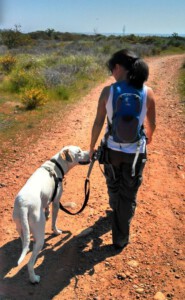Guest Blog: Load Up, Pup! by Chey Anne Maes
The Proficient Pup

It’s Time for a Road Trip!
“Load up Buddy, letʼs hit the road!” My dog jumps right into his crate and settles on his bed, gnawing away at his bully stick. His crate takes up a good chunk of cargo space with our bags tucked into what little space is left on the side. Next to his crate are a full jug of water, his water bowl, poop bags, and tasty treats for easy access at rest stops. Before we start our road trip, I look over my dogʼs checklist once more:
- Food/Food Bowl
- Extra leashes
- Treats/Kong/Toys
- Pet First Aid Kit
- Dog Bed/Blanket
- Veterinary records/vaccination record
- Towels/Paper Towels to clean up messes
- Water/water bowl
- Collar & ID tag on dog
- Poop Bags
- Brush
- Medication/Supplements
- Microchip up-to-date with your current information
Cicero and I have taken countless road trips over the past 10 years and I love that he is able to travel along with us. Iʼve learned a few things along the way to ensure long car rides are enjoyable for him. Keep in mind, some things I learned the hard way. There was the time his tummy had a horrible reaction to a calming tablet; I think you can figure out the rest of that story. So, here are a few pointers to ensure you and your dog enjoy a comfortable and safe road trip together.
Before your trip:
- Schedule a visit with your veterinarian to safeguard your dogʼs health while traveling. This would be a good time to discuss preventative medicines about fleas, ticks, heart worms, and other diseases or risks that are prevalent in the area you plan to visit.
- Plan your route to include pet friendly hotels, restaurants, and tourist attractions. I suggest calling to confirm the hotel, tourist attraction, or park to discuss the pet policy with a representative.
- In case your dog may need medical attention, have the address and phone number of veterinary clinics in the area.
- Be informed and research state and county pet laws of the areas you plan to travel through and at your destination. For example, in California, it is illegal to leave your pet unattended in a motor vehicle if the animal could be at risk for for injury or death (CA Penal Code Section 597.7). Be sure to also check state and county laws for breed specific legislation for the places you will be driving through and visiting.
- Practice taking short car rides with your dog to prepare them for the long road trip. During the short car ride, make note of any signs of stress your dog may display, including excessive panting, whining, barking, inability to settle down, or car sickness. Should your dog show signs of distress or car sickness, you may want to consult with your veterinarian for preventative options to make your dog more at ease during your travels.
- Invest in the right-size crate or carrier for your dog. Your dog should be able to stand, turn around, and lay comfortably in his crate. You want your dog to find that his crate is a safe and happy place. To help accomplish this, make the crate a desirable place to be by scattering a few morsels of his special treats or setting a favorite toy inside.
On the Road:
- Having your dog restrained or in a crate is for the dogʼs safety as well as the safety of those traveling with you. Depending on where you are traveling to and from, you may need to roll your window down to speak with a border patrol agent and many of the border check points employ working canines. Having your dog confined helps to ensure the safety of everyone you may encounter while traveling on the road.
- Remember to tend to your dogʼs needs. Keep your dog hydrated and offer them a chance to go potty or explore every 2-3 hours. Have your dog on leash before they exit the car to prevent them from escaping and getting lost. Also, pick up and dispose of your petʼs waste appropriately.
- Be mindful of elevation changes. My own dog started to pant and drool excessively while we traveled up into the mountains. It never occurred to me that she could not get her ears to “pop” until I spoke with our veterinarian. Proactively keeping her ears clean to prevent ear infections and providing her with a chew toy, such as a kong stuffed with treats, seemed to alleviate the discomfort in elevation changes as we drove through the mountains.
Youʼve arrived!
- Once youʼve arrived at your destination, keep your dog confined or restrained until youʼve unloaded your belongings. Set up their sleeping and feeding area and be sure to provide your dog the opportunity to “sniff out” the new environment. One of my favorite things that I look forward to after being on the road for several hours is spending a few minutes with my dog to unwind – a game of tug or fetch, or curling up with my dog and resting my eyes.
Planning, preparing, and a little bit of research will open the door for future road trip adventures with your dog. You know your dog best; if a road trip for your furry friend is too stressful or places you would like to visit would prove to be too difficult, then you may want to consider hiring a pet sitter and giving Fido a stay-cation instead. Ultimately, you and your dog want to enjoy the time you spend together and that may not include long road trips. Perhaps the lessons Iʼve learned will help you make the best decision for you and your dog.
– Chey Anne Maes, KPA CTP, is a professional, certified dog trainer in San Diego, CA


